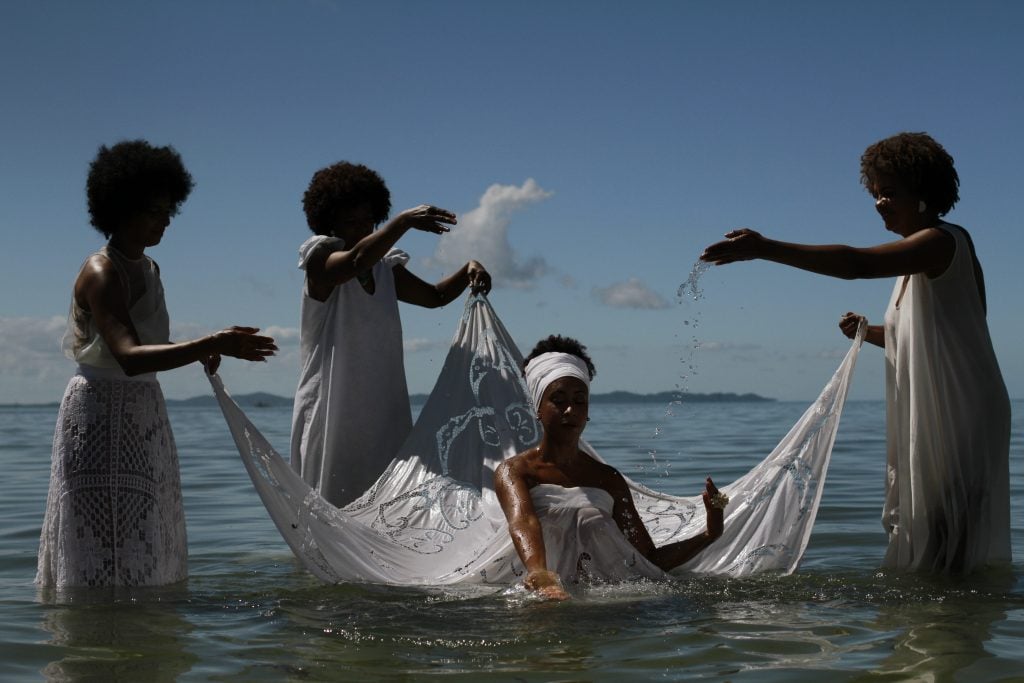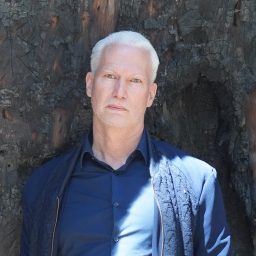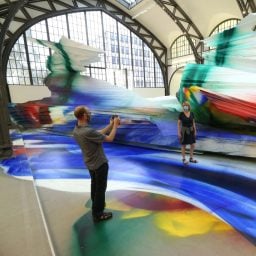Berlin’s grand House of World Cultures has always had a bureaucratic feeling to it. Besides its Modernist stone walls and wide polished steps—of the sort seen in concert venues—its logic is rather reminiscent of a government building. No mystery there: the historic hall was a gift from the American government to West Berlin in 1957.
The site, nestled along a canal in Berlin’s Tiergarten, was not chosen for its prettiness alone, but because it served a strategic function. The boundary to East Berlin was a few hundred meters from the house’s perimeter. Soon enough, the House of World Culture’s iconic shell-shaped roof would be one of the few sites visible to those on the other side of the Berlin wall.
All that connotative weight still hangs heavy in the building’s bones decades on. Yet it promises to have a new sensibility this year with director Bonaventure Soh Bejeng Ndikung. The 46-year-old Cameroonian curator took the reins in January, succeeding Bernd Scherer who had been director for 17 years.
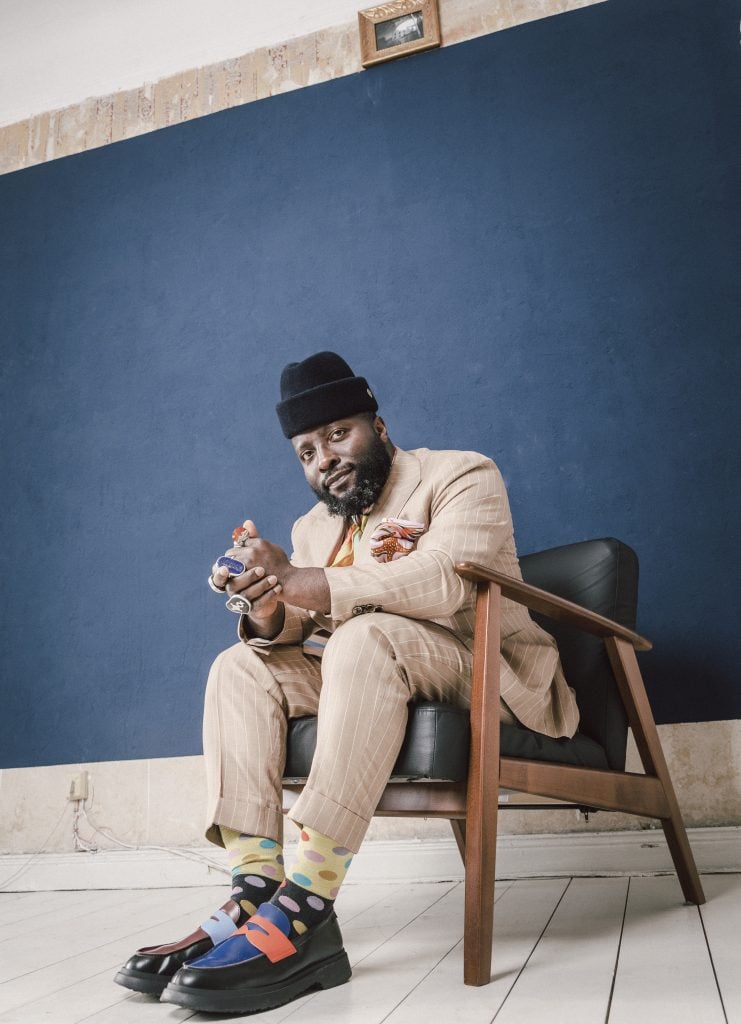
Prof Dr Bonaventure Soh Bejeng Ndikung, Director and Chief Curator Haus der Kulturen der Welt. Photo: Alexander Steffens/HKW
“It’s not meant for passersby,” Ndikung said of the layout of building he inherited, as we sat together inside of the intendant’s office, the seat of power for the institution. Tucked in one corner just beyond the reception desk, the room had received a fresh coat of paint, rich tones of deep magenta and a velvety dark blue. The wall colors and the warmth they bring were a tiny sliver of the ambitious overhauls underway.
Ndikung’s approach is rigorous and multi-sensorial. Another small example: his first press conference in March was accompanied by live music.
When we met, the new director was wearing accents of colors that seemed as opulent as the walls around him. A colorful “picto sonic” mural by Tanka Fonta was being installed on the foyer. “One of the things we are trying to do is make the building more porous, more accessible,” he said.
On June 1, Ndikung hopes to make the house feel truly open to all, in the form of a cross-pollination of events and a 90-artist exhibition called “O Quilombismo,” over a weekend that falls under the umbrella of “Acts of Opening Again: A Choreography of Conviviality.”
The plan is to work with the building, not against it. The Henry Moore sculpture that punctuates the institution’s dizzying long entrance way—noted as the heaviest work the artist ever made—will now be flanked by colorful flags. But they will not be nation-state flags, rather artist-designed flags that will change along with the exhibition program.
“We want to move the mountain to the people,” Ndikung said. “It’s a difficult building, but it’s very exciting. Once you start thinking of methodologies of subverting power, this institution is ever-giving.”
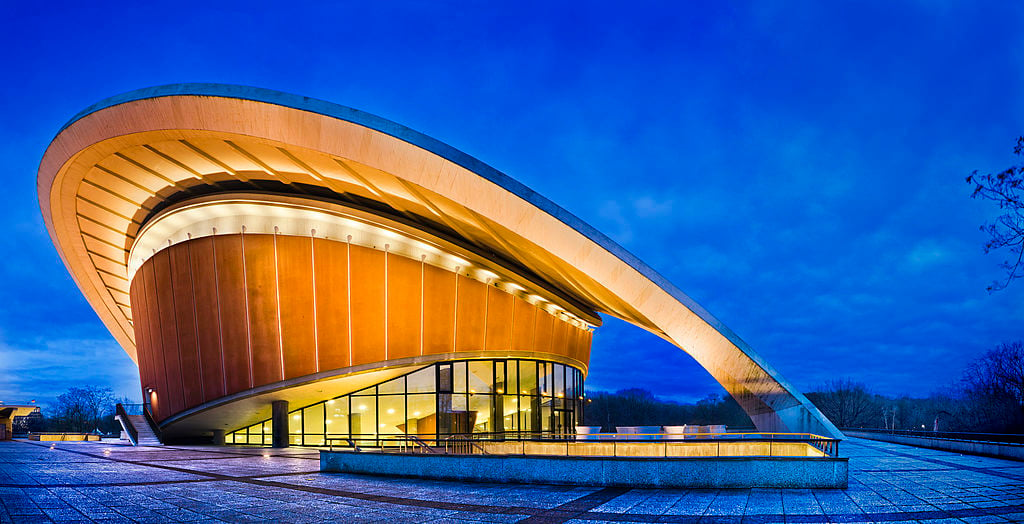
The Haus der Kulturen der Welt (House of World Cultures) in Berlin, Germany.
Ndikung has been visiting the museum since he moved to Germany in 1997—with only 300 Deustche Marks in his pocket—to get his doctorate in medical biotechnology. He also gained a doctorate in biophysics before moving into the art world.
Less than a decade later, he founded what is now a cornerstone institution in Berlin, SAVVY Contemporary, a discursive art space that bridges the Western and non-Western art worlds. As such, Ndikung’s practice has long encompassed multiple worlds, and so the House of World Cultures is an obvious fit for him.
In addition, he is a powerful writer, and often contributes essays that become flash points in conversations. His newest book, Pidginization as Curatorial Method, will be published in August. As a curator, he worked with Adam Szymczyk on his critically acclaimed Documenta 14 exhibition, which brought Greece and Germany, then in a dark stalemate over austerity measures, into confrontation.
So he is more than equipped to take on the legacy of the House of World Cultures, and the German public and state that backs it. “There was a question that Adam used to propose: to whom does Documenta belong?” Ndkung said. “Who owns these institutions? [The House of World Cultures] is a state-run institution, but who owns the state? It is the people.”
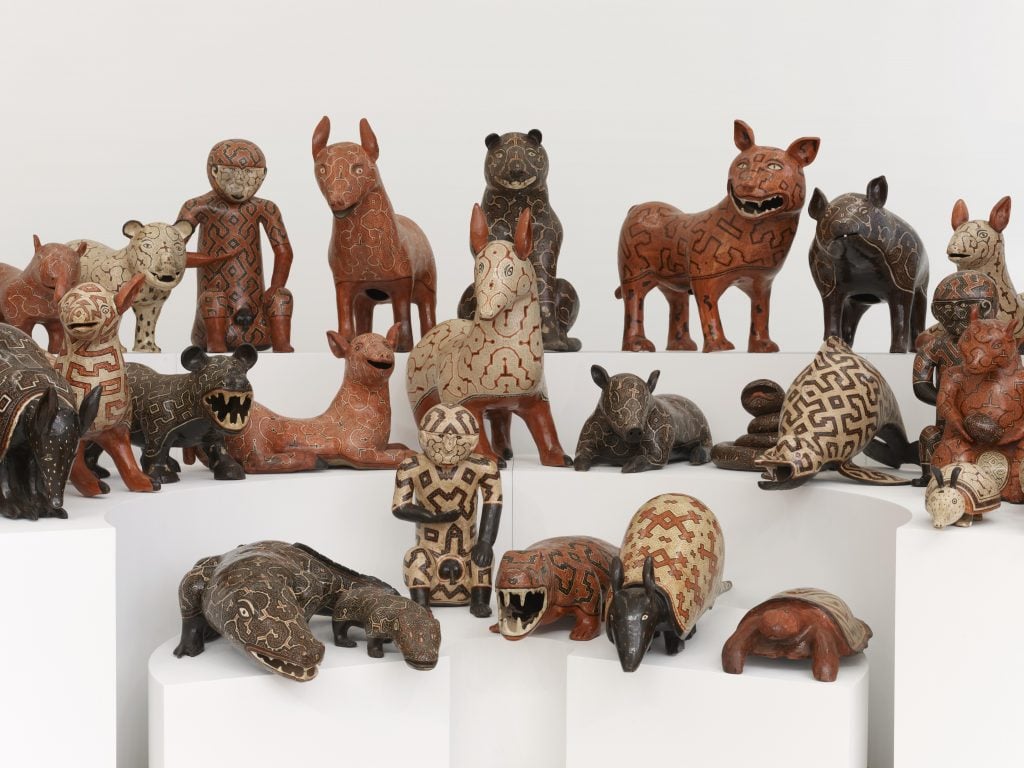
Celia Vasquez Yui with Diana Ruiz Vasquez, The Council of the Mother Spirits of the Animals (2020/2023), installation, coil-built pre-fire slip-painted clay, vegetal resins. Photo: Elisabeth Bernstein. Courtesy of the artists; Shipibo Conibo Center, NY; Salon 94, NY.
Therein will be a delicate dance. The public here tends to have a lot to say about its institutions and its Documenta editions—which is not a bad thing, but there is a noted pressure. Complicating that is the fact that this country still struggles with its racism and antisemitism. Ndikung, the first Black curator to lead one of the capital’s major institutions and someone who is deeply invested in worlds beyond the strictures of the global north and west, will have to navigate this.
“This is a very derogatory way of talking about the multicultural,” noted Ndikung when asked about how he is maneuvering the complex problems in the German political landscape. “At the same time, there is a fetishization of diversity. These two are at loggerheads. People want you to be of the world, but the world should be seen from a very particular prism.”
Ndikung has learned that his moves are being watched very carefully. Some weeks after his appointment was announced last year, German newspaper Die Welt questioned his position on the pro-Palestinian BDS movement. He has stressed that he is against boycotts. “It’s very tiring and extremely daunting,” he said of the media and political gaming that goes on when one is positioned as the “first” of something.
“But we have to put things into perspective,” he noted, along a longer stretch of history of discrimination tactics. “What we’re going through is minute. Yes, its massively tiring. But [others] fought a bigger fight. We cannot afford to give up. There’s too much more to do. We have a generational task.”
At the same time he said he and his team and collaborators are moving with caution. “We are learning from the traps that were set,” he noted.
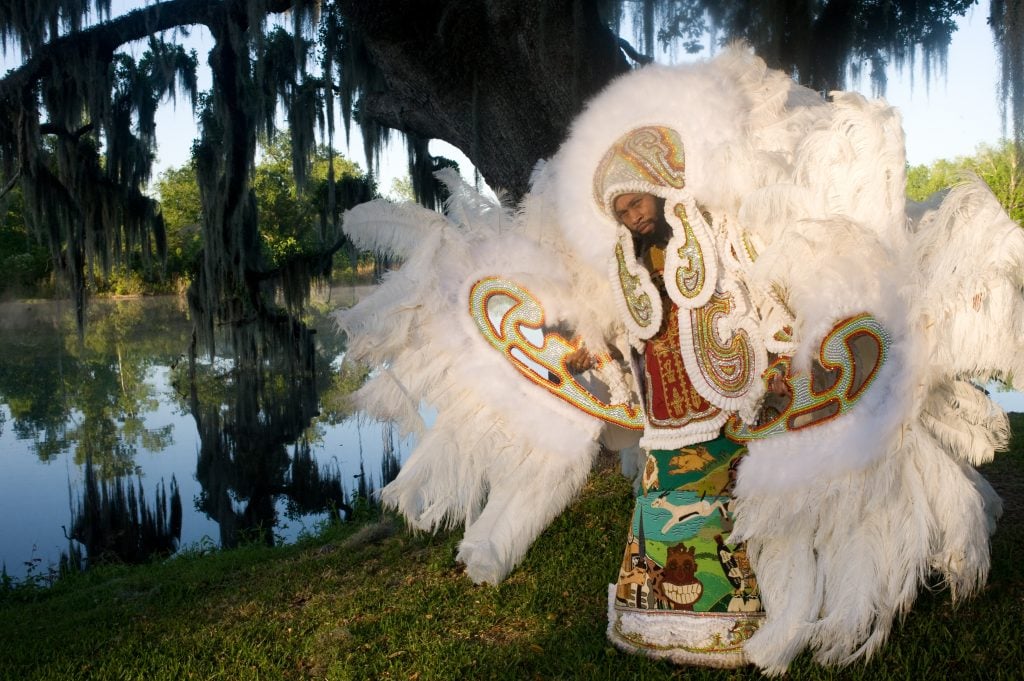
Big Chief Demond Melancon, Africa (2011), beading, glass beads, rhinestones on canvas, framed, 96.52 × 121.92 cm. Photo: Christopher Porché West. Courtesy of the Arthur Roger Gallery.
Accompanying the central show during opening weekend will be music, food, and dance. Ndikung stressed when discussing his program that forms of history are, for much of the world, not only carried in texts and visual codes. “If we want to dance, it is fine, because it’s how we have carried our knowledge. It is not just music, it is carrying knowledge,” he said.
Highlights of the weekend include the Cuban artist María Magdalena Campos-Pons who will be holding cleansing rituals to help renew and transform the energy of the building. Chef Fatmata Binta, from Sierra Leone, will be hosting cooking sessions at the museum’s restaurant. Jamaican novelist Sylvia Wynter Foyer is hosting a participatory walk throughout the public sites in and around the building, dubbed a “pregnant oyster.” A children’s discotheque will take place on Saturday afternoon; there will also be childcare available throughout the opening weekend, alongside a slew of music events.
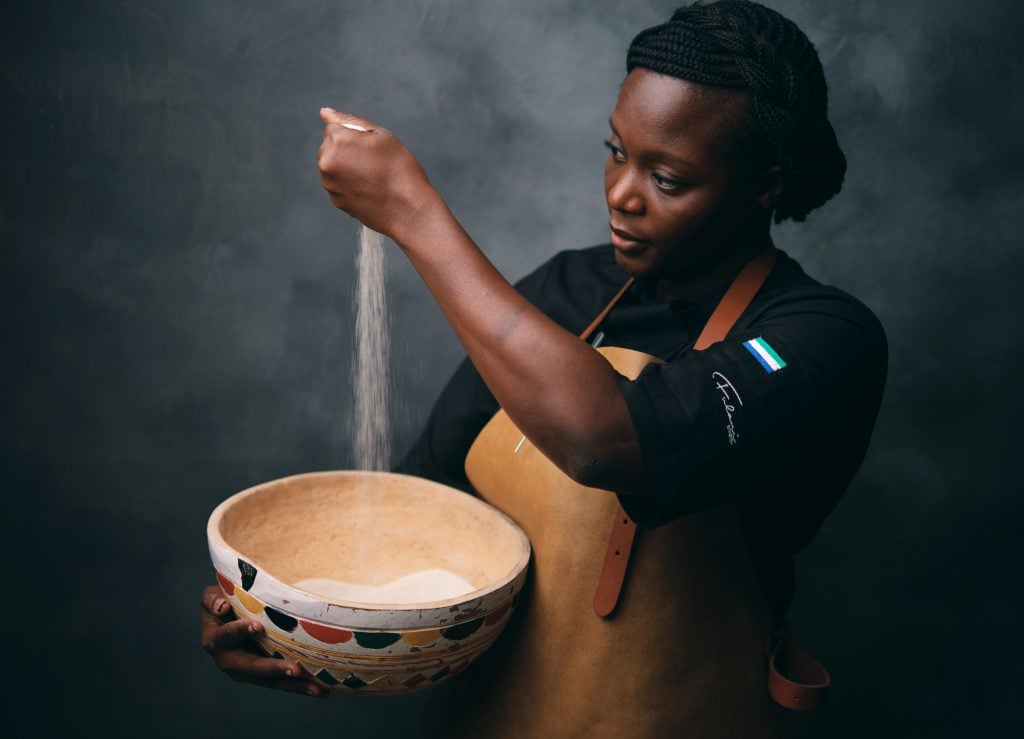
Chef Fatmata Binta working with fonio, an ancient African super grain. Photo: Apag Studios.
Such a new approach takes extra efforts. “There are certain boundaries we are still learning how to overcome,” Ndikung said. “We want to dismantle this institution and rebuild it, using the same bricks. We find the bricks important, but the institution needs to be rethought,” he added.
To start, Ndikung brought together an international team with a diverse skillset, including Can Sungu, a Turkish curator who will head up the museum’s cinematic program. The German-Jewish visiting curator Max Czollek will bring in the local poetry and theater scenes.
The new team is listed on the website alphabetically, which means Adrian Pilling, head of lighting, is at the top of the list. The idea here is to point to how integral every part of the team is to the house’s success. “We can’t come in here and say we want to think about new worlds, but then still implement tyrannical structures.”
Still to come over the next months are projects that will run over a longer term. The O Quilombismo school, which launches as part of the opening exhibition, will continue for years. “Echoes of the Bruderlander” will take place over the next year and look at the German Democratic Republic’s relationship to former “brother” socialist nations like Vietnam, Cuba, and Mozambique.
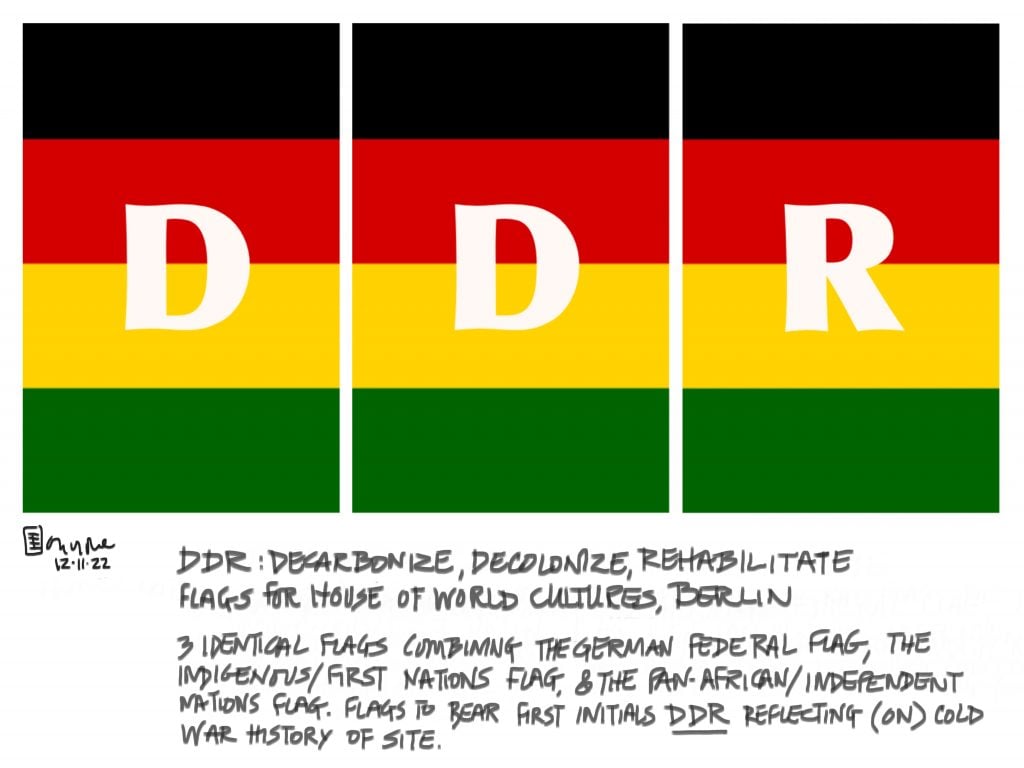
Olu Oguibe, Sketch for DDR: Decarbonize, Decolonize, Rehabilitate (2023), textile work, 3 flags. Courtesy of the artist.
When it comes to the opening this week, Ndikung noted among his personal highlights is the performance by nora chipaumire and Germaine Acogny, who won the Golden Lion for Lifetime Achievement at the Venice Biennale for Dance in 2021. The two artists are planning a procession into the venue with five Senegalese performers. Another highlight is the Congelese music star Awilo Longomba.
“Music is art, but it doesn’t have to be mediated by the brain, it is mediated by the body,” Ndikung said. “It’s the sound that tickles the cell. What we’re going to try to do here is to have people become concerned about something. To do that, you have to feel it, it has to touch you.”
That is political, he added, citing something the musician Paul Robson once told the singer Harry Belafonte. “One way you can cross a barrier, especially the racial one,” Ndikung quoted, “is to make them sing your song.”
More Trending Stories:
A British Couple Actually Paid Nearly $250,000 to Remove a Banksy Mural From Their Building Due to the ‘Extremely Stressful’ Upkeep
Archaeologists in Hungary Have Uncovered the Remains of an Ancient Roman Doctor Alongside His Surgical Toolkit
The World’s First A.I.-Generated Statue, Cobbling Together the Styles of Five Celebrated Sculptors, Has Landed in a Swedish Museum
Meet the Young Collectors Calling the Shots at the Guggenheim, a Highly Placed Art Worlder’s Anti-Woke Tweets, and More Art World Gossip
An Extraordinary Wristwatch Belonging to the Last Emperor of China Just Sold for $6.2 Million, Setting Multiple Auction Records
A Sculpture Depicting King Tut as a Black Man Is Sparking International Outrage
Archaeologists Have Found a 3,000-Year-Old Bakery in Armenia, After Realizing a Layer of Ash Was Actually Wheat Flour
Why the Supreme Court’s Decision in the Andy Warhol Copyright Case Shows the Dangers of a Sympathy Vote
An Exhibition of Taylor Swift’s Stuff Has Just Opened at the Museum of Arts and Design. Here Are 5 Must-See Displays, Swifties
